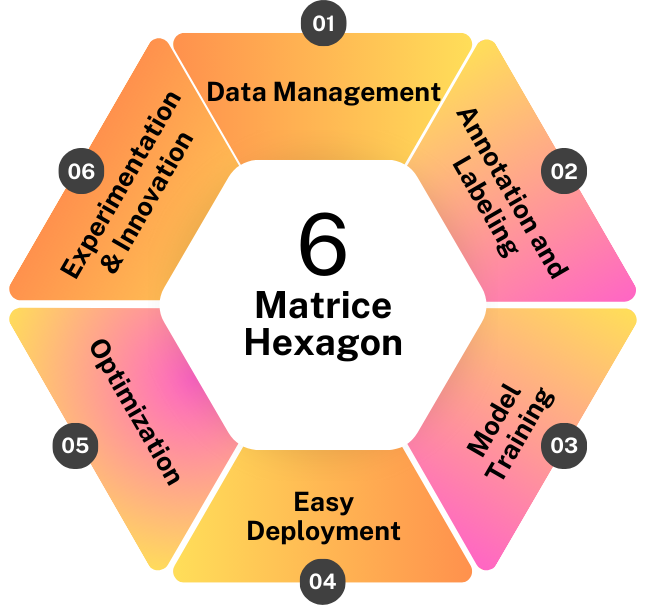Redefining Machine Learning Challenges with Matrice
Mar 7, 2024

It is truly a watershed moment for humanity as we are witnessing the befitting prowess of artificial intelligence and machine learning throughout the world. These technological marvels have enhanced our ability to innovate, transform, and grow tremendously. Not to mention the impactful, ever-evolving, and oh-so-beneficial computer vision applications.
In today’s fast-paced world, where technology reigns supreme and innovation knows no bounds, the possibilities are endless. Whether you are dreaming up groundbreaking applications for image recognition, revolutionizing healthcare with diagnostic algorithms, or boosting profits by automating manufacturing processes, the sky’s the limit when it comes to leveraging the POWER OF AI!
Unprecedented Growth of Computer Vision
Computer vision technology aims to understand the content of digital images. It has become a reliable and mature technology that brings cost savings and saves time across various applications. These applications found their home in agriculture, healthcare, automotive, and manufacturing industries. Computer vision is a rapidly growing field and has seen exponential growth in the last few years thanks to new hardware and advanced algorithms.
The global computer vision market was worth USD 14.10 billion in 2022 and is projected to grow at a CAGR of 19.6% from 2023 to 2030. With increased accuracy rates, today’s systems are more accurate than humans in many cases. Computer vision is taking on increasingly complex challenges and achieving accuracy that rivals humans performing the same tasks.
From Complexity to Accessibility
But let’s face it – diving headfirst into the world of machine learning and computer vision can be a daunting task. From navigating complex algorithms to wrangling massive datasets and everything in between, the road to success can seem like an uphill battle.
This means that building a computer vision or an ML project would require extensive technical knowledge, expertise, a lot of time, and resources, which are often scarce and expensive.
The whole process from envisioning the project to giving it a life can be daunting and that is why 80% of ML projects do not make it to production.
That’s where Matrice.ai comes in – your ultimate partner in crime on this exhilarating journey of exploration and discovery. Whether you’re a seasoned tech guru or a budding entrepreneur with a big idea, Matrice.ai is the perfect playground for turning your vision into reality.
So, why should you choose Matrice, you ask? Well, grab a seat, and let me tell you why this platform is the game-changer you’ve been waiting for! From its user-friendly interface to its robust suite of tools and resources, Matrice is designed to empower you every step of the way.
Addressing Machine Learning Challenges with Matrice
Matrice.ai enables individuals, businesses, and developers to overcome obstacles faced while working on computer vision projects:

1. Substandard Data Quality
High-quality labeled and annotated image datasets fuel computer vision systems. Accurate data annotation is the key to success for the machine learning models as they get trained on it. However, data annotation, data collection, and data labeling are rigorous and tedious tasks that are expensive and not free of human error.
Furthermore, data quality is vital too and often varies depending on the source, format, and context of the images. Therefore, high standards should be maintained throughout the entire process.
How Matrice comes in:
Matrice provides a data-centric platform that facilitates users to upload data from multiple sources such as URLs, local disks, or LabelBox. Matrice supports functionality such as data creation from existing datasets, data versioning, data splitting, data balancing, data cleaning, and data visualization aids.
Matrice also offers collaborative labeling and reviewing, annotation history and guideline support, sample issue handling, and ML-assisted labeling using foundation models such as CLIP and OWL-VIT.
2. Lack of Competent Hardware
To effectively process and analyze vast amounts of visual data, there is simply no substitute for powerful hardware when it comes to computer vision systems. Without the necessary processing power, these systems simply cannot keep up with the demands of modern data analysis.
Hardware is usually costly, limited, and incompatible with different software frameworks and models. Also, hardware optimization is a great challenge for edge devices and real-time applications.
How Matrice comes in:
Matrice provides a flexible and scalable platform that supports various hardware types and configurations. Users can train and deploy models on data center CPUs/GPUs, and edge devices like Android and iOS.
Matrice has excellent inference runtime optimization for enhanced performance and lower cost using ONNX, OpenVino, and TensorRT. Last but not least, Matrice.ai enables runtime inference optimization for reducing memory footprint and auto-scaling for handling variable workloads.
3. Complex Model Development
Handling complex scenarios and interdependent tasks can be challenging for computer vision systems. These systems require advanced models that are expensive to develop, time-consuming, and resource-intensive. Selection and fine-tuning the best model for a specific use case can be challenging, especially for novices.
How Matrice comes in:
Matrice has a wide array of standard and state-of-the-art open-source models for image classification and detection. For image classification, we offer an assortment of models including DenseNet, MobileNet, WideResNet, GoogleNet, InceptionV3, ResNet, EfficientNetV2, EfficientNet, SqueezeNet, ViT, ShuffleNet, AlexNet, and VGG.
These models offer varying architectures and performance characteristics, allowing users to choose the most suitable model for their specific use cases. YOLOv8, one of the dominating object detection models, comes at the heart of Matrice.
It also supports AutoML for model selection and training, balancing the trade-off between latency and performance. It empowers users to train models based on target deployment devices, customize hyper-parameter selection based on user expertise, and evaluate models on any dataset.
4. Cumbersome Deployment
Even if a model is perfected, deploying it seamlessly into production is a whole different beast. Computer vision systems require seamless and secure integration with various applications and products. Moreover, monitoring and updating models can be a nightmare, especially for dynamic and evolving environments.
How Matrice comes in:
Matrice solves this problem by providing a user-friendly and robust platform that allows users to deploy and integrate models with ease. Matrice supports single-click model deployment on data center CPUs/GPUs.
It also has API support for integration into user apps and products. Importantly, Matrice.ai has API key support for better security, a dashboard for real-time API prediction traffic visualization, and drift monitoring for model maintenance.
5. Infrastructure Costs - Cheapest Computing is the Way to Go!
Deploying AI models can be a computationally intensive task, which often results in high infrastructure costs. This can discourage individuals and organizations from pursuing innovative projects. Therefore, the affordability of computing resources plays a crucial role in enabling widespread adoption and innovation in computer vision.
How Matrice comes in:
Matrice is a platform that helps users optimize their infrastructure costs by providing them with cost-effective solutions for training and deploying AI models. Users can scale their AI projects without having to worry about incurring huge expenses.
By making AI technologies more affordable and accessible, Matrice is democratizing access to these cutting-edge technologies, thereby allowing more individuals and organizations to explore innovative applications in computer vision.
Matrice: Beyond a Solution
An end-to-end machine learning platform for developing and integrating deep learning models for computer vision applications is the need of the hour as it imparts:
Modernized Workflow
An end-to-end platform offers super convenient and integrated workflow. It eliminates the unnecessary labor and complexity of managing assorted tasks at the different stages of the projects.
There would be healthy and efficient collaboration among team members irrespective of their expertise.
Time and Resource Management
From data collection to model deployment, the lifecycle of the project includes many tasks. A platform like Matrice optimizes these tasks to the fullest. By leveraging this platform, one doesn’t need to keep switching between the processes and tools.
As a result, a lot of time and resources would be saved. This gives an impetus to the progression of the project and leaves no chances for errors.
Tech Support for All
The nature of the platform is such that everyone involved in computer vision or machine learning projects, regardless of their diverse levels of expertise and knowledge, can benefit. Matrice incorporates low code and no-code functionalities so that everyone can understand and contribute to the projects.
Community and Support
Matrice comes with a supportive community and regular updates. This community fosters knowledge-sharing, problem-solving, and collaboration among users. Regular updates ensure that the platform stays current with the latest advancements in machine learning and computer vision.
Enter the imperative need for an end-to-end platform Matrice.ai – a cohesive and well-thought solution designed by ML EXPERTS for the ML COMMUNITY to navigate the maze of the entire project lifecycle.
In the contemporary landscape, where time is of the essence, resources are precious, and expertise is diverse, an end-to-end platform for machine learning or computer vision projects has emerged as an indispensable ally.
Think CV, Think Matrice
Experience 40% faster deployment and slash development costs by 80%